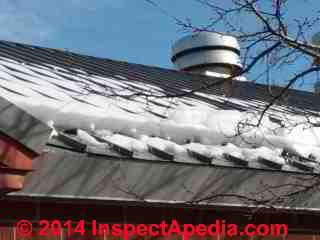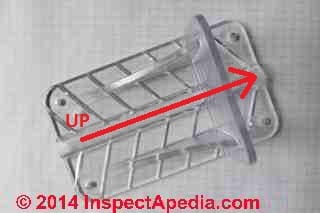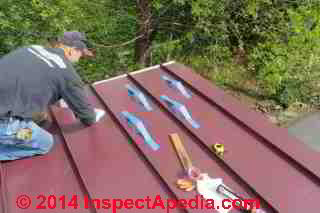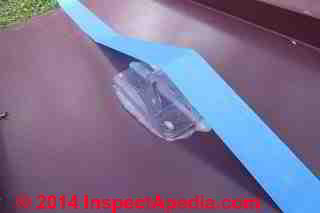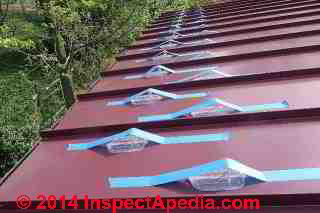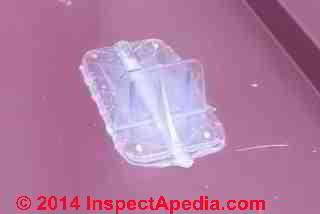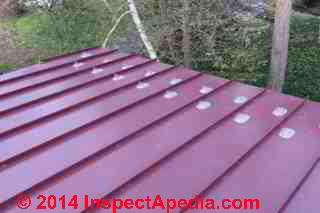 Glue-On Roof Snow Guards
Glue-On Roof Snow Guards
How to install adhesive snow guards on smooth-surfaced roofs
- POST a QUESTION or COMMENT about successfgul glue-on adhesive-type snow guards & snow retention systems on buildings
Glue-on roof snow brakes & snow guards:
This article describes the steps in a successful glue-on type snow brake system for smooth surfaced roofing, using a metal roof as an example.
Adhesive-bonded snow brakes are used on a variety of smooth surfaced roofs besides metal, including glass, plastic, and some other roof covering materials. We explain why some glue-on roof snow guards fail - being pushed off of the roof by snow loads, and we describe how to make sure the glue-on snow guards will work on your roof.
This article series illustrates types of snow guards or snow brakes or other snow retention devices used on metal, rubber, asphalt, and slate roofs and we explain and illustrate in photographs just how and where these devices are attached to building roofs. We give the reasons for snow & ice retainer use and their history.
InspectAPedia tolerates no conflicts of interest. We have no relationship with advertisers, products, or services discussed at this website.
- Daniel Friedman, Publisher/Editor/Author - See WHO ARE WE?
How to Install Glue-Down Snow Guards on a Metal, Glass, or other Smooth-Surfaced Roof
We agree with opinions encountered among roofers that it's better to glue snow guards to a metal roof (or use device that clamp to the standing seam) for two reasons:
- Leaks: Even though some snow guards are sold with pre-drilled holes for mechanical fastening of the retaining device to the roof surface, every nail or screw is another hole in the roof, and another potential leak.
- Thermal damage: Mechanically bonding a flat-bottomed snow guard to a metal roof may result in roof damage, tearing, leaks, connector hole elongation during wide temperature swings on the roof.
Thermal expansion differences between the snow guard itself and the metal roof surface may be substantial. Superbond's SB-190, in contrast, can tolerate significant thermal change without damage.
Steps in Gluing Snow Guards to a Roof Surface
Because of the problem of poor adhesion of the snow guard to the roof that later come loose or creep down the metal roof, manufacturers offer tips for a successful installation including:
- Choose & buy enough snow guards before starting the job. Measure the roof dimensions and pitch, then consult SNOW GUARD SPACING & PATTERN to determine how many you will need. Choose a type and size of snow guard that will work with your roof area, pitch and the connection method you've selected.
In this example we're using Berger's clear surface mount snow guard that's got a large surface and enough thickness that we don't expect the guard to break in use.
I know, it's not rocket science, but having inspected a number of snow guard installations that have failed by bending, breaking, sliding off the roof, or simply being inadequate to resist the quantity and loads of snow involved, it makes sense to stop and think a minute rather than just gluing any-old-thing up on the roof on a hope and a prayer.
We bought 30 snow guards to permit two per "bay" in staggered rows between the standing seams of the metal roof being addressed. On a larger or steeper roof we'd have needed more snow guards in more than one set.

- Snow guard adhesive choice & adhesive use procedure: For attaching plastic snow retention clips or guards Berger's catalog recommends use of Surebond's SB-190 Everseal adhesive sealant.
We purchased our snow guards and adhesive sealant from a local roofing supplier, working with ABC Supply Co. Inc., in Poughkeepsie, NY. (SNOW GUARD PRODUCT SOURCES)
This product will bond permanently to metal, plastic, roofing materials, fiberglass glass, vinyl, pick-proof cement, painted surfaces, cement, wood, and other surfaces.
The product tolerates a wide range of temperatures, bonds to 2,000 psi, is flexible to 500% elongation, and is rated for a 30 year life. We are using this adhesive to bond clear plastic snow brakes to a low slope standing seam metal roof and will report on the results here.
Surebond SB-190 is not recommended for use on copper or soft expansion joints, nor on polystyrene or styrene-containing plastics.
Watch out: some adhesive products such as Surebond's SB-190, while very effective, also contain toxic VOCs and other chemicals including Heptane (CAS # 64742-89-8) and Toluene (CAS # 108-88-3). Be sure to read and follow the manufacturer's installation and use instructions.
Watch out: buy more adhesive than you think you'll need. We were gluing 30 Berger snow guards in two rows and estimated using three tubes of sealant. I bought six and ran out while gluing the 30th guard.
This sealant is not so easy to spread, making following the manufacturer's instructions to leave no air bubbles and be sure there is runout around the snow guard a little bit of a challenge. In turn that meant using more sealant than anticipated, and possibly more than necessary, as you'll see below. Better to use too much and be a bit ugly than to use too little and have ice heaves and freeze-thaw cycles push the snow guards off of the roof. - Buy necessary cleaning supplies: paper towels, denatured alcohol or other surface cleaner, gloves, etc. if you don't already have these on hand. Don't start a job high on a roof without thinking you've got everything you need.
- Check the weather against the snow guard manufacturer's instructions. When you're gluing snow guards you want the temperature to be above 50F, the roof surface to be dry, and you want a weather prediction of no rain while you're working.
Watch out: you also want to wait until after the snow season. Snow load will push newly-glued snow guards down the roof and off. - Make other on-roof repairs first: if you need to repair gutters, plumbing vents or something else that is anywhere around the to-be-glued snow guard area, do that work first so you won't go walking among and kicking askew the newly-glued guards.
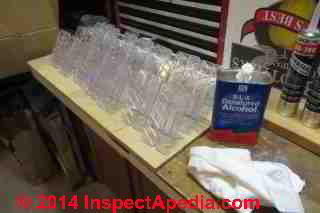
- Clean the snow guards before installing them on the roof. Release agents, grease, dust, dirt on the snow guard bottom surface can prevent good adhesion to the roof surface.
In the photo at left we're using denatured alcohol to clean the snow guard bottoms before taking them up to the roof.
After cleaning these parts keep your greasy fingers off of the guard bottom, or clean the guard again before installation if necessary. - Read the instructions from the manufacturer regarding how the snow guard adhesive should be applied - how much, at what temperatures, with how much runout at the edges of the snow guard.
- Watch out: Secure your ladder and follow safe on-roof work practices. Working on roofs leads to more serious fall injuries than most other construction jobs. Then bring the work materials to the roof surface.
- Clean the metal roof surface in the area where the snow guard is to be glued. The surface needs to be clean of dust, dirt, oil, release agents, waterproofing agents (such as silicone spray), and water. We use isopropyl alcohol which has not, in our experience harmed the metal roof's finish surface.
Above you can see alcohol for cleaning the roof surface, adhesive & caulk gun, paper towels, a bag for trash, gloves, my wood spacing stick, measuring tape, blue masking tape, and the first snow guard glued in place and secured with tape.
Above Eric is using alcohol to clean the area where the snow guard will be bonded to the roof. We worked as a team, one man cleaning and marking, the other gluing, pressing, and taping each snow guard in place.
Watch out: Some other solvents such as acetone are not recommended as they will dissolve paint or other coloration on the roof, while other recommended solvents such as xylene may work well but can be highly toxic and thus more dangerous to handle.
We used simple denatured alcohol to clean the metal roof surface as well as the surface of plastic glue-on snow guards.
- Clean the roof surface again if you've walked over the area where you're about to glue. Make sure the surface is dry too.
- Measure & mark the snow guard locations. Eric Galow (Galow Homes, Poughkeepsie NY) and I used a pre-cut scrap of wood to mark the lower snow guard location and to space each one uniformly away from the metal roof standing seam. On this low slope roof, 16" up from the roof edge marked the building exterior wall, over which the first row of snow guards was placed. Measuring up 31" to the bottom of the second staggered row of snow guards gave us the location for the second row.
- Apply the adhesive sealant to the snow guard bottom and press it in place. Get in a good working position so that you can both apply an even coat of adhesive to the guard bottom (uneven coating means air bubbles means poor adhesion) and also so that you can quickly press the guard into position after it's coated. Press down uniformly and firmly until there is adhesive runout and so that the snow guard is not tipped.
Watch out: pay attention to the "UP" arrows marked on the snow guard. Placing a snow guard in the upside down position will reduce its ability to withstand the force of snow and ice on the roof. Each Berger snow guard is embossed with two arrows and the word "UP" - the longer tail of the snow guard goes down-roof.
Adhesive runout: use enough adhesive that there are no air bubbles under the snow guard and that there is a runout of about 1/8 to 1/4" (it can be tooled) around all of the edges of the snow guard in contact with the roof. This detail helps prevent water from getting below the snow guard where freeze-thaw cycles will try to push it off of the roof.
Watch out: Leaving no adhesive run-out may look better but it asks for snow and ice push that ultimately loosens the snow guard. At below right you can see the runout at the last snow-guard we installed - as we ran out of adhesive sealant. I made sure that there was runout at the up-slope and sides of this snow guard. After the initial sealant had cured sufficiently I re-visited the roof, inspected every snow guard and installed additional sealant at any edge that looked suspicious including the lower or down-roof edge of the guard at below right
...
- Keep the snow guards in position: Use string, blue making tape, or other support clamped across the roof to hold the snow guards in place until the adhesive is fully cured.
String: really? In my opinion, using string to keep the snow guards in place, recommended by some manufacturers, is ridiculous. Because even a tight string will sag under pressure, you'd have to clamp the string to every roof seam. We liked the blue masking tape because it will peel away later without leaving residue on the roof.
- Snow guard adhesive curing time: the adhesive used with glue-on snow retainers often needs up to four weeks to cure, longer if temperatures are below 50 degF
During the curing process the snow guards may creep down a hot roof, a cold roof, a dirty roof, a roof that was wet during installation, or just because the roof god was not on your side. .
Above at the previous bullet you can see our snow guard taped in position across the lower end of the metal roof using blue masking tape.
Indeed, checking the adhesive 24 hours later, while it had formed a not-sticky skin, it was still very soft. On a steep roof or in adverse conditions it's no surprise that the snow guards might creep own the roof.
Since this adhesive sealant needs 4 weeks to fully cure we just left the tape up there for a while.
At above left you can see the clear plastic Berg snow guards after the blue tape had been removed. Two weeks after installation the adhesive was not fully cured. We were also into May and not worried about snow accumulation pushing these snow guards off of this low slope roof.
Watch out: do not glue-down snow retainers on a metal roof or any other roof surface before the end of the snow season. If there is a heavy snowfall before the adhesive/sealant has fully cured the snow guards may be pushed out of position or may be pushed completely off of the roof by the weight of snow and ice.
Watch out: What happens if you defer installing snow guards on a roof where they're needed? Take a look at SNOW GUARD FAILURES and at PLUMBING VENT REPAIR and you can see both damage and how that damage was later repaired.
- Corrugated metal roofs also accept snow guards, typically made of bronze or galvanized iron and referred to as a Snow Guard Shoe.[1]
- Slate roofs (photos shown earlier in this article series) using long horizontal snow brakes mount the brake or fence on brackets nailed to the roof, with the nailed portion of the mounting bracket extending up under succeeding courses of slates to avoid risk of leaks around mounting bolts.
...
Continue reading at SNOW GUARD SPACING & PATTERN or select a topic from the closely-related articles below, or see the complete ARTICLE INDEX.
Or see these
Recommended Articles
Suggested citation for this web page
SNOW GUARD GLUE ON INSTALLATION at InspectApedia.com - online encyclopedia of building & environmental inspection, testing, diagnosis, repair, & problem prevention advice.
Or see this
INDEX to RELATED ARTICLES: ARTICLE INDEX to BUILDING ROOFING
Or use the SEARCH BOX found below to Ask a Question or Search InspectApedia
Ask a Question or Search InspectApedia
Try the search box just below, or if you prefer, post a question or comment in the Comments box below and we will respond promptly.
Search the InspectApedia website
Note: appearance of your Comment below may be delayed: if your comment contains an image, photograph, web link, or text that looks to the software as if it might be a web link, your posting will appear after it has been approved by a moderator. Apologies for the delay.
Only one image can be added per comment but you can post as many comments, and therefore images, as you like.
You will not receive a notification when a response to your question has been posted.
Please bookmark this page to make it easy for you to check back for our response.
IF above you see "Comment Form is loading comments..." then COMMENT BOX - countable.ca / bawkbox.com IS NOT WORKING.
In any case you are welcome to send an email directly to us at InspectApedia.com at editor@inspectApedia.com
We'll reply to you directly. Please help us help you by noting, in your email, the URL of the InspectApedia page where you wanted to comment.
Citations & References
In addition to any citations in the article above, a full list is available on request.
- [1] Berger Snow Retention Systems, Berger Building Products, 805 Pennsylvania Blvd.
Feasterville, PA 19053
Toll-free: 800-523-8852805,
Email: info@bergerbuildingproducts.com, Website: BergerBuildingProducts.com
See: http://www.bergerbuildingproducts.com/pdfs/catalog_snowguards.pdf - [2] Precision Snow-Guards, AceClamp®, Standing Seam Metal Roof Supplies, Precision Snow-guards™ - c/o PMC Industries, Inc. 87 Spring Lane, Plainville, CT 06062 Tel: (860) 229-SNOW (7669) provides clear or colored plastic snow guards for metal and rubber roofs, available in "King" and "Queen" sizes. Tel: (860) 229-SNOW (7669). Website: http://www.snow-guards.com/snowguards.php
- [3] S-5!® Snow Retention Systems, S-5! Attachment Solutions,
Metal Roof Innovations, LTD.
8655 Table Butte Road
Colorado Springs, CO 80908
(888) 825-3432, Email: info@s-5.com, Website: http://www.s-5.com/snow/
The company's products include milled solid block aluminum snow rail mounting clamps of varying shapes & designs. We are evaluating the S-5! clamps provided by this company. These clamps attach to the standing seams on a metal roof and in turn are used to attach a snow rail or snow fence. The company also provides solar panel hold-downs for metal roofs.- Ed. - [4] SnoBar™, Tel: 800-711-9724, Website: http://www.snobar.com/index.html The company's products include a patented one-piece roof clamp bracket & other brackets for attaching bars used as snow rails or snow fences. No street address was provided.
- [5] Alpine SnowGuards® 289 Harrel Street Morrisville, VT 05661 Tel: 888-766-9994, Email: info@alpinesnowguards.com Website: http://www.alpinesnowguards.com/ [No direct retail sales]
- [6] ATAS Snow Retention Products, ATAS Headquarters Allentown, Pennsylvania 18106 Phone: 800-468-1441 FAX: 610-395-9342 Email: info@atas.com, Website: http://www.atas.com/Company/Contact.aspx
- [7] Pacific Sheet Metal, Aspen Office & Shop, 401 Aspen Airport Business Center Aspen, Colorado 81611, Email: sales@pacificsheetmetal.net, Tel: 970.925.2454. The company provides a line of very sturdy snow rails or fences that mount to the seams of a metal roof.
- [8] Gough Snow Guards, Brookfield IL, Tel: 708-485-6272, Website: http://www.snoguard.com/ The company's products include copper snow guards installed on slate roofs and tile roofs, as well as standing seam metal roof snow retention systems.
- [9] AMSI Supply 4333 Lynwood Ct, Douglasville, GA 30134, metal roofing components, Tel: 800-943-9771
- [10] SnowGrip, 126 Woodward Ave., Iron Mountain, MI 49801, Tel: 06-396-7000, Email: mark@snowgripit.com Website: http://www.snowgripit.com/
- [15] Eric Galow, Galow Homes, Lagrangeville, NY. Mr. Galow can be reached by email: ericgalow@gmail.com or by telephone: 914-474-6613. Mr. Galow specializes in residential construction including both new homes and repairs, renovations, and additions.
- [17] "From Asbestos to Zinc, Gutters", Technical Preservation Services, National Park Service, U.S. Department of the Interior, web search 9./29.10, original source: http://www.nps.gov/history/hps/tps/roofingexhibit/gutters.htm
- [19] Asphalt Roofing Residential Manual from ARMA the Asphalt Roofing Manufacturers Association Website https://www.asphaltroofing.org/product/residential-asphalt-roofing-manual/ ,
- [20] Terry Anderson, "Snow Retention - the Invisible Code", web search 7/13/12, original source: http://snow.tra-mage.com/news-articles/snow-retention-the-invisible-code.html [copy on file as: Anderson Dec 2011 Interface.pdf ]
- Building Pathology, Deterioration, Diagnostics, and Intervention, Samuel Y. Harris, P.E., AIA, Esq., ISBN 0-471-33172-4, John Wiley & Sons, 2001 [General building science-DF] ISBN-10: 0471331724 ISBN-13: 978-0471331728
- Building Pathology: Principles and Practice, David Watt, Wiley-Blackwell; 2 edition (March 7, 2008) ISBN-10: 1405161035 ISBN-13: 978-1405161039
- Built-Up Roof Systems, Manual, C.W. Griffin, Mcgraw-Hill (Tx); 2nd edition (July 1982), ISBN-10: 0070247838, ISBN-13: 978-0070247833
- Concrete Folded Plate Roofs, C. Wilby PhD BSc CEng FICE FIStructE (Author), Butterworth-Heinemann, 1998, ISBN-10: 0340662662, ISBN-13: 978-0340662663
- Concrete Roofing Tile, History of the, Batsford, 1959, AISN B000HLLOUC (available used)
- Copper Roofing, by CDA
- Copper Roofing, Master specifications for copper roofing and sheet metal work in building construction: Institutional, commercial, industrial, I.E. Anderson, 1961 (hard to find)
- Corrugated Iron, Building on the Frontier, Simon Holloway
- Handbook of Building Crafts in Conservation, Jack Bower, Ed., Van Nostrand Reinhold Company, NY 1981 ISBN 0-442-2135-3 Library of Congress Catalog Card Nr. 81-50643.
- Historic Preservation Technology: A Primer, Robert A. Young, Wiley (March 21, 2008) ISBN-10: 0471788368 ISBN-13: 978-0471788362
- Historic Slate Roofs : With How-to Info and Specifications, Tina Skinner (Ed), Schiffer Publishing, 2008, ISBN-10: 0764330012 , ISBN-13: 978-0764330018
- Low Slope Roofing, Manual of, 4th Ed., C.W. Griffin, Richard Fricklas,
McGraw-Hill Professional; 4 edition, 2006, ISBN-10: 007145828X, ISBN-13: 978-0071458283
- Roof failure causes in depth (and specific methods for avoiding them)
- Roof design fundamentals and flourishes, based on voluminous industry research and experience
- New technologies and materials -- using them safely and correctly
- Comprehensive coverage of all major roofing systems pecifications, inspection, and maintenance tools for roofing work
- Metal Roofing, an Illustrated Guide, R.A. Knowlton , [metal shingle roofs],
- Problems in Roofing Design, B. Harrison McCampbell, Butterworth Heineman, 1991 ISBN 0-7506-9162-X (available used)
- Roofing The Right Way, Steven Bolt, McGraw-Hill Professional; 3rd Ed (1996), ISBN-10: 0070066507, ISBN-13: 978-0070066502
- Slate Roofs, National Slate Association, 1926, reprinted 1977 by Vermont Structural Slate Co., Inc., Fair Haven, VT 05743, 802-265-4933/34. (We recommend this book if you can find it. It has gone in and out of print on occasion.)
- Roof Tiling & Slating, a Practical Guide, Kevin Taylor, Crowood Press (2008), ISBN 978-1847970237,
- The Slate Roof Bible, Joseph Jenkins, www.jenkinsslate.com, 143 Forest Lane, PO Box 607, Grove City, PA 16127 - 866-641-7141 (We recommend this book).
- Tile Roofs of Alfred: A Clay Tradition in Alfred NY
- Wood Shingle Roofs, Care and Maintenance of wood shingle and shake roofs, (EC), Stanley S. Niemiec (out of print)
- Our recommended books about building & mechanical systems design, inspection, problem diagnosis, and repair, and about indoor environment and IAQ testing, diagnosis, and cleanup are at the InspectAPedia Bookstore. Also see our Book Reviews - InspectAPedia.
- In addition to citations & references found in this article, see the research citations given at the end of the related articles found at our suggested
CONTINUE READING or RECOMMENDED ARTICLES.
- Carson, Dunlop & Associates Ltd., 120 Carlton Street Suite 407, Toronto ON M5A 4K2. Tel: (416) 964-9415 1-800-268-7070 Email: info@carsondunlop.com. Alan Carson is a past president of ASHI, the American Society of Home Inspectors.
Thanks to Alan Carson and Bob Dunlop, for permission for InspectAPedia to use text excerpts from The HOME REFERENCE BOOK - the Encyclopedia of Homes and to use illustrations from The ILLUSTRATED HOME .
Carson Dunlop Associates provides extensive home inspection education and report writing material. In gratitude we provide links to tsome Carson Dunlop Associates products and services.


